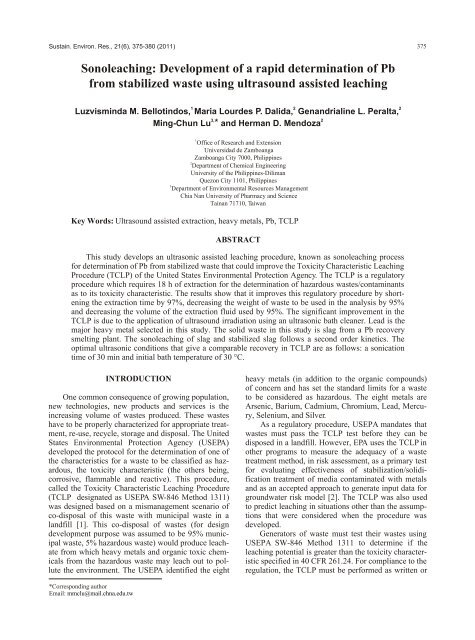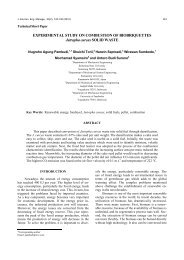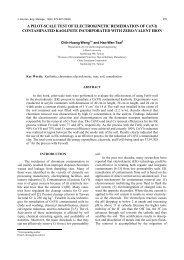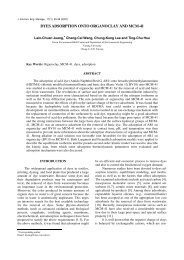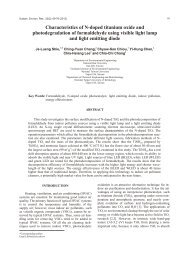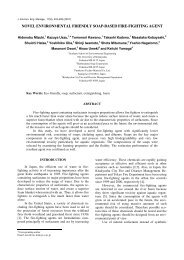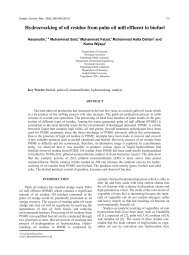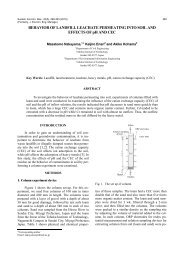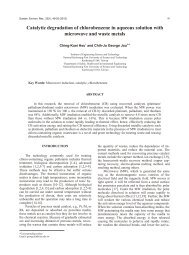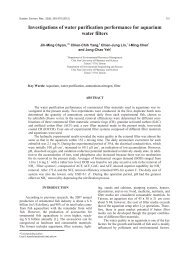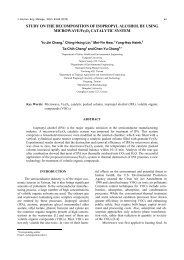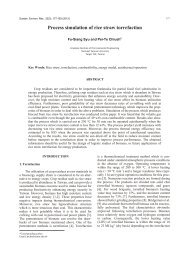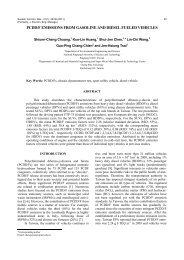Sonoleaching: Development of a rapid determination of Pb ... - SER
Sonoleaching: Development of a rapid determination of Pb ... - SER
Sonoleaching: Development of a rapid determination of Pb ... - SER
You also want an ePaper? Increase the reach of your titles
YUMPU automatically turns print PDFs into web optimized ePapers that Google loves.
Sustain. Environ. Res., 21(6), 375-380 (2011) 375<br />
<strong>Sonoleaching</strong>: <strong>Development</strong> <strong>of</strong> a <strong>rapid</strong> <strong>determination</strong> <strong>of</strong> <strong>Pb</strong><br />
from stabilized waste using ultrasound assisted leaching<br />
Luzvisminda M. Bellotindos, Maria Lourdes P. Dalida, Genandrialine L. Peralta,<br />
3, 2<br />
Ming-Chun Lu * and Herman D. Mendoza<br />
1 2 2<br />
1<br />
Office <strong>of</strong> Research and Extension<br />
Universidad de Zamboanga<br />
Zamboanga City 7000, Philippines<br />
2<br />
Department <strong>of</strong> Chemical Engineering<br />
University <strong>of</strong> the Philippines-Diliman<br />
Quezon City 1101, Philippines<br />
Department <strong>of</strong> Environmental Resources Management<br />
Chia Nan University <strong>of</strong> Pharmacy and Science<br />
Tainan 71710, Taiwan<br />
3<br />
Key Words: Ultrasound assisted extraction, heavy metals, <strong>Pb</strong>, TCLP<br />
ABSTRACT<br />
This study develops an ultrasonic assisted leaching procedure, known as sonoleaching process<br />
for <strong>determination</strong> <strong>of</strong> <strong>Pb</strong> from stabilized waste that could improve the Toxicity Characteristic Leaching<br />
Procedure (TCLP) <strong>of</strong> the United States Environmental Protection Agency. The TCLP is a regulatory<br />
procedure which requires 18 h <strong>of</strong> extraction for the <strong>determination</strong> <strong>of</strong> hazardous wastes/contaminants<br />
as to its toxicity characteristic. The results show that it improves this regulatory procedure by shortening<br />
the extraction time by 97%, decreasing the weight <strong>of</strong> waste to be used in the analysis by 95%<br />
and decreasing the volume <strong>of</strong> the extraction fluid used by 95%. The significant improvement in the<br />
TCLP is due to the application <strong>of</strong> ultrasound irradiation using an ultrasonic bath cleaner. Lead is the<br />
major heavy metal selected in this study. The solid waste in this study is slag from a <strong>Pb</strong> recovery<br />
smelting plant. The sonoleaching <strong>of</strong> slag and stabilized slag follows a second order kinetics. The<br />
optimal ultrasonic conditions that give a comparable recovery in TCLP are as follows: a sonication<br />
time <strong>of</strong> 30 min and initial bath temperature <strong>of</strong> 30 °C. .<br />
*Corresponding author<br />
Email: mmclu@mail.chna.edu.tw<br />
INTRODUCTION<br />
One common consequence <strong>of</strong> growing population,<br />
new technologies, new products and services is the<br />
increasing volume <strong>of</strong> wastes produced. These wastes<br />
have to be properly characterized for appropriate treatment,<br />
re-use, recycle, storage and disposal. The United<br />
States Environmental Protection Agency (USEPA)<br />
developed the protocol for the <strong>determination</strong> <strong>of</strong> one <strong>of</strong><br />
the characteristics for a waste to be classified as hazardous,<br />
the toxicity characteristic (the others being,<br />
corrosive, flammable and reactive). This procedure,<br />
called the Toxicity Characteristic Leaching Procedure<br />
(TCLP designated as USEPA SW-846 Method 1311)<br />
was designed based on a mismanagement scenario <strong>of</strong><br />
co-disposal <strong>of</strong> this waste with municipal waste in a<br />
landfill [1]. This co-disposal <strong>of</strong> wastes (for design<br />
development purpose was assumed to be 95% municipal<br />
waste, 5% hazardous waste) would produce leachate<br />
from which heavy metals and organic toxic chemicals<br />
from the hazardous waste may leach out to pollute<br />
the environment. The USEPA identified the eight<br />
heavy metals (in addition to the organic compounds)<br />
<strong>of</strong> concern and has set the standard limits for a waste<br />
to be considered as hazardous. The eight metals are<br />
Arsenic, Barium, Cadmium, Chromium, Lead, Mercu-<br />
ry, Selenium, and Silver.<br />
As a regulatory procedure, USEPA mandates that<br />
wastes must pass the TCLP test before they can be<br />
disposed in a landfill. However, EPA uses the TCLP in<br />
other programs to measure the adequacy <strong>of</strong> a waste<br />
treatment method, in risk assessment, as a primary test<br />
for evaluating effectiveness <strong>of</strong> stabilization/solidification<br />
treatment <strong>of</strong> media contaminated with metals<br />
and as an accepted approach to generate input data for<br />
groundwater risk model [2]. The TCLP was also used<br />
to predict leaching in situations other than the assumptions<br />
that were considered when the procedure was<br />
developed.<br />
Generators <strong>of</strong> waste must test their wastes using<br />
USEPA SW-846 Method 1311 to determine if the<br />
leaching potential is greater than the toxicity characteristic<br />
specified in 40 CFR 261.24. For compliance to the<br />
regulation, the TCLP must be performed as written or<br />
.<br />
.
376 Bellotindos et al., Sustain. Environ. Res., 21(6), 375-380 (2011)<br />
the results are not valid for the purposes <strong>of</strong> determining<br />
whether the waste is hazardous based on toxicity<br />
characteristic.<br />
.<br />
In the Philippines, Congress enacted many laws to<br />
address the management and control <strong>of</strong> increasing<br />
volume <strong>of</strong> wastes produced. One <strong>of</strong> these laws, the<br />
Toxic Substances and Hazardous and Nuclear Wastes<br />
Control Act <strong>of</strong> 1990 (Republic Act 6969), was enacted<br />
in response to the increasing problems related to toxic/hazardous<br />
chemicals and nuclear wastes in the country.<br />
The implementing rules and regulations <strong>of</strong> this Act<br />
require the use <strong>of</strong> TCLP.<br />
.<br />
Rossi [3] described leaching as a complex dissolution<br />
process that requires suitable reactants in aqueous<br />
solution to come in contact with the mineral particles<br />
to be dissolved. TCLP estimates the extent <strong>of</strong> leachability<br />
<strong>of</strong> hazardous constituents from solid wastes under<br />
certain conditions. This procedure consists <strong>of</strong> many<br />
components, one <strong>of</strong> which is the extraction with simulated<br />
leaching fluid using a rotary apparatus for 18 h.<br />
This, in addition to the time for sample preparation before<br />
extraction and the final separation <strong>of</strong> liquid and<br />
solid phases for final analysis <strong>of</strong> the target constituents,<br />
is time consuming. The total time for a TCLP <strong>determination</strong><br />
can reach 22 h.<br />
.<br />
This limitation <strong>of</strong> TCLP may be addressed by replacing<br />
the 18-h contact time in a rotary extractor with<br />
ultrasound assisted extraction. Ultrasound is the sound<br />
with frequency beyond the human hearing threshold<br />
[4]. The human hearing frequency is normally 16 to 18<br />
kHz. The use <strong>of</strong> ultrasound in extraction has been<br />
gaining popularity in the past decade although researches<br />
on ultrasonics started in the late 1920s and<br />
into 1940s [5], but interest on the application <strong>of</strong> ultrasound<br />
dates back more than 100 yr [6]. Ultrasound is a<br />
useful tool in enhancing reaction rates in many reaction<br />
systems. This rate enhancement is called<br />
sonochemistry.<br />
.<br />
Sonochemistry, which is the use <strong>of</strong> ultrasound to<br />
enhance or alter chemical reactions [6], began in the<br />
late 1800s. However, as mentioned by Thompson and<br />
Doraiswamy [6] in their review paper on sonochemistry,<br />
the term was first used by Neppiras in 1980<br />
in his review <strong>of</strong> acoustic cavitation. Chemical effects<br />
<strong>of</strong> ultrasound include improved conversion and yield,<br />
change in reaction pathway or initiation or reactions in<br />
chemical, biological or electrochemical systems.<br />
Ultrasound also results in physical effects which<br />
include increasing the surface area <strong>of</strong> the reactants and<br />
accelerating dissolution.<br />
.<br />
The driving force in sonochemistry is cavitation;<br />
the formation, growth and implosive collapse <strong>of</strong> bubbles<br />
in a liquid [7,8] which generates heat and produces<br />
intense local heating (5000 °C) and high pressure<br />
(200 MPa). This type <strong>of</strong> cavitation resulting from<br />
the application <strong>of</strong> sound waves is known as acoustic<br />
cavitation [9]. The effect <strong>of</strong> cavitation within the liquid<br />
depends on the type <strong>of</strong> system where it is generated. In<br />
the case <strong>of</strong> a solid-liquid system, cavitation collapse<br />
near a particle can lead to shock waves that can break<br />
the particle apart or force it into <strong>rapid</strong> motion. These<br />
result in interparticle collisions that cause erosion,<br />
wetting <strong>of</strong> the particles, surface cleaning and particle<br />
size reduction [4].<br />
Many studies have been conducted on the various<br />
applications <strong>of</strong> ultrasound including the effects <strong>of</strong> ultrasound<br />
assisted extractions <strong>of</strong> metals from soils, sediments<br />
and solid wastes. In these studies, researchers<br />
found that ultrasound provided savings in extraction<br />
time. Collasiol et al. [10] developed and established a<br />
method for mercury extraction in sediment and soil<br />
using ultrasound and results showed that the method<br />
was fast and mercury loss was prevented. The leaching<br />
yield <strong>of</strong> the silver content <strong>of</strong> a mining waste was investigated<br />
by Öncel et al. [11]. The experiment showed<br />
that silver may be leached almost completely from the<br />
solid waste <strong>of</strong> a silver ore plant by means <strong>of</strong> ultrasound<br />
assisted thiourea leaching method.<br />
Al-Merey et al. [12] investigated the experimental<br />
conditions <strong>of</strong> an ultrasonic cleaning bath for quantitative<br />
extraction <strong>of</strong> lead, copper and zinc metals from<br />
soil samples. The results showed that the performance<br />
<strong>of</strong> the method was equal to a hot-plate digestion method<br />
and significantly reduced the hazardous and<br />
fumehood emissions.<br />
Mason et al. [13] reviewed current laboratory<br />
research and potential for the scale-up <strong>of</strong> chemical<br />
decontamination using ultrasound and concluded that<br />
the use <strong>of</strong> ultrasound in the laboratory cleaning <strong>of</strong> soil<br />
samples proved to be effective and some large scale<br />
trials showed promise. Meegoda and Perera [14] in an<br />
attempt to develop a technology to decontaminate<br />
heavy metals in dredged sediment using ultrasound<br />
coupled with vacuum pressure concluded that although<br />
the clay fraction could not be effectively treated by this<br />
technology, chromium was immobile in the clay fraction<br />
<strong>of</strong> the treated sediment and was safe for disposal.<br />
Marin et al. [15] developed a method for <strong>determination</strong><br />
<strong>of</strong> zinc and arsenic speciation in soils using focused<br />
ultrasound. The method, which replaced extraction<br />
with mechanical shaking by sonication to simplify<br />
analytical procedures was optimized and validated.<br />
In a study by Perez-Cid et al. [16], the use <strong>of</strong> focused<br />
ultrasound was applied to a sludge sample to<br />
shorten the operation time in each <strong>of</strong> the stages corresponding<br />
to a sequential extraction method proposed<br />
by the Community Bureau <strong>of</strong> Reference (BCR). The<br />
sonication conditions (sonication power and time) were<br />
optimized and extraction <strong>of</strong> copper, chromium, nickel,<br />
lead and zinc was compared with the conventional<br />
three stage sequential extraction method. The use <strong>of</strong><br />
ultrasound represented a valid alternative to the con-<br />
ventional shaking and reduced the operation time.<br />
In a similar work, the use <strong>of</strong> ultrasound provides a<br />
saving in extraction time relative to a conventional<br />
mechanical shaking as shown by Kazi et al. [17] who<br />
developed a <strong>rapid</strong> version <strong>of</strong> the three-stage BCR<br />
sequential extraction to release heavy metals from<br />
.<br />
.<br />
.<br />
.<br />
.
untreated waste samples. The use <strong>of</strong> ultrasonic bath<br />
<strong>of</strong>fered the advantage <strong>of</strong> replicate extractions that can<br />
be carried out simultaneously. Munoz et al. [18] proposed<br />
a combination <strong>of</strong> ultrasonic extraction and stripping<br />
technique (anodic stripping voltammetry) for<br />
routine analysis <strong>of</strong> copper and lead <strong>determination</strong> in<br />
lubricating oil samples. The method which used an<br />
ultrasonic bath provided the advantage <strong>of</strong> simultaneous<br />
sample pretreatment. Bellotindos [19] showed that<br />
sonication is better than extraction by TCLP on extraction<br />
<strong>of</strong> <strong>Pb</strong> from synthetic soil. Table 1 lists some<br />
studies on <strong>Pb</strong> leaching by various sonoleaching operation<br />
(frequency and time). .<br />
Table 1. Some studies on ultrasound assisted<br />
extraction <strong>of</strong> <strong>Pb</strong><br />
Sample<br />
BCR certified<br />
reference sediments<br />
Extraction<br />
time (min)<br />
5-60<br />
Frequency<br />
(kHz)<br />
Edible seaweed 10 35<br />
Sediments 5-35 50-60<br />
To determine the effects <strong>of</strong> two or more factors or<br />
how these factors interact with each other, experiments<br />
are performed. In the past, the one-factor-at-a-time<br />
approach, where one factor is varied over the range <strong>of</strong><br />
given condition while keeping all other factors constant,<br />
was practiced. This method is time consuming<br />
and does not consider the interaction between factors<br />
[23]. The Design <strong>of</strong> Experiment is a planned approach<br />
in determining cause and effect relationship [24] using<br />
inputs and outputs that can be measured. This approach<br />
has become a strategy <strong>of</strong> researchers to shorten the<br />
time <strong>of</strong> the study in terms <strong>of</strong> the number <strong>of</strong> experimental<br />
runs and to save on expensive trials. To optimize<br />
multivariate systems, statistical s<strong>of</strong>tware packages<br />
such as Design-Expert 7 are used by researchers.<br />
Optimization is achieved by Factorial Design analysis<br />
[25,26], Fractional Factorial Design [27,28] or Re-<br />
sponse Surface Methodology [29].<br />
There is a growing concern for the increasing<br />
amount <strong>of</strong> <strong>Pb</strong> as a contaminant in the environment and<br />
as an environmental health issue. It poses great risks to<br />
human health due to its proven toxicity. This research<br />
explored the use <strong>of</strong> an ultrasound assisted leaching for<br />
a <strong>rapid</strong> <strong>determination</strong> <strong>of</strong> <strong>Pb</strong> from stabilized waste. In<br />
this study, stabilized waste from slag was made to find<br />
out the effects <strong>of</strong> ultrasound in extracting the metal and<br />
comparing it with TCLP extraction and to find out the<br />
mechanism <strong>of</strong> extraction with ultrasound. The optimal<br />
conditions comparable to TCLP extraction were determined.<br />
.<br />
MATERIALS AND METHODS<br />
1. Chemicals and Analytical Methods .<br />
Bellotindos et al., Sustain. Environ. Res., 21(6), 375-380 (2011)<br />
% <strong>Pb</strong><br />
extracted<br />
48-54<br />
0.6-1.4<br />
-1<br />
(µg g )<br />
7.6 -1<br />
(µg g )<br />
Reference<br />
Canepari et al.<br />
[20]<br />
Dominguez-<br />
Gonzalez<br />
et al. [21]<br />
Elik<br />
[22]<br />
.<br />
The water for all solution preparations was ultrapure<br />
water (18.27 MÙ cm at 29 °C) supplied by<br />
RODA ultrapure water systems. <strong>Pb</strong> was analyzed using<br />
PerkinElmer AAnalyst 200 Atomic Absorption Spectrophotometer.<br />
The rotary agitator for the TCLP was<br />
supplied by Cherng Huei Co. (Taiwan), Model RA-<br />
326, 40 W, 110 V with timer and rpm control. The<br />
temperature feature <strong>of</strong> the Suntex conductivity meter<br />
was used to measure temperature.<br />
.<br />
2. <strong>Sonoleaching</strong> Set-up<br />
The source <strong>of</strong> ultrasound was DELTA Ultrasonic<br />
Cleaner (tank capacity = 10.8 L, operating frequency<br />
= 40 kHz). The ultrasonic bath has a temperature and<br />
time control which can be changed in increments <strong>of</strong> 1.<br />
The reaction flask is suspended by the use <strong>of</strong> a clamp<br />
and the level <strong>of</strong> the liquid in the reaction bath is kept at<br />
the level <strong>of</strong> the water bath. The bath temperature is<br />
monitored by the temperature feature <strong>of</strong> a Suntex conductivity<br />
meter. Figure 1 shows the actual picture <strong>of</strong><br />
the set-up.<br />
.<br />
3. Extraction Procedures<br />
377<br />
For extraction by TCLP, the USEPA SW-846<br />
Method 1311 was used. For ultrasound procedure, distilled<br />
water was poured into the ultrasonic bath to a<br />
level about 5.1 cm from the rim and degassed for 5-10<br />
min. An amount <strong>of</strong> the sample was weighed into a 250<br />
mL Erlenmeyer flask. The extraction fluid (TCLP ex-<br />
Fig. 1. Sonication set-up.<br />
traction fluid) was added using the solid to liquid ratio<br />
<strong>of</strong> 1:20. Five flasks were prepared for the different<br />
ultrasound exposure time (15-90 min). The flask was<br />
suspended in the bath such that the level <strong>of</strong> the extraction<br />
fluid in the flask was at the same level as the water<br />
in the tank. A temperature probe was suspended at the<br />
same level as the bottom <strong>of</strong> the flask. The duration<br />
time was set and ultrasound was applied. The bath<br />
temperatures at the start and end <strong>of</strong> sonication were<br />
noted. The concentration <strong>of</strong> the <strong>Pb</strong> in the extract was<br />
determined by Atomic Absorption Spectrometer. .<br />
.<br />
.
378<br />
4. Preparation <strong>of</strong> the Stabilized Slag<br />
The waste sample used in this study is a slag from<br />
a <strong>Pb</strong> recovery smelting plant. The slag was pulverized<br />
to pass sieve #35 (0.5 mm). Ordinary Portland cement<br />
was used to stabilize the slag. A 1:1 ratio <strong>of</strong> slag to<br />
cement was used. 750 g <strong>of</strong> slag and 750 g <strong>of</strong> ordinary<br />
Portland cement were weighed and thoroughly mixed.<br />
Deionized water was added until a paste like consistency<br />
was obtained. The mixture was then poured into<br />
a mould and allowed to cure for 3 wk. After the curing<br />
period, the stabilized waste was then pulverized again<br />
to pass sieve #35.<br />
.<br />
5. Design <strong>of</strong> Experiment<br />
The Design-Expert 7 [30] consists <strong>of</strong> three major<br />
parts, the actual design, the analysis process and the<br />
optimization. In the actual design, the factors, parameters<br />
and expected responses considered in the study<br />
are used to determine the minimum number <strong>of</strong> runs.<br />
The response data are then used in the analysis process<br />
which includes full analysis <strong>of</strong> the variance. The optimization<br />
part determines the combination <strong>of</strong> factors<br />
and responses that simultaneously satisfy the requirements<br />
<strong>of</strong> the factors and responses.<br />
.<br />
RESULTS AND DISCUSSION<br />
A second order equation based on dissolution [31]<br />
can be expressed in the form:<br />
(1)<br />
Where k = rate constant <strong>of</strong> second order dissolu-<br />
tion, S = maximum dissolution (g), S = solubility (g),<br />
max<br />
and T = sonication time, min<br />
The equation is then linearized to:<br />
(2)<br />
Where intercept = r = initial dissolution rate =<br />
1/(k S ) and slope = reciprocal <strong>of</strong> the dissolution<br />
max<br />
equilibrium = 1/S .<br />
max<br />
The straight lines in Figs. 2a and 2b are the graphs<br />
<strong>of</strong> the linearized form <strong>of</strong> the second order dissolution<br />
equation (Eq. 2) which shows that dissolution <strong>of</strong> <strong>Pb</strong><br />
with ultrasound follows a second-order kinetics. Table<br />
2 shows the values <strong>of</strong> S , r and k for the slag and<br />
max<br />
stabilized slag as determined from the lines in Figs. 2a<br />
and 2b.<br />
.<br />
The optimization feature <strong>of</strong> the Design-Expert 7<br />
can generate a combination <strong>of</strong> solutions for optimal<br />
conditions. These are ranked in the order <strong>of</strong> desirability.<br />
Table 3 shows the optimization criteria for the<br />
<strong>determination</strong> <strong>of</strong> optimal conditions. For factors [<strong>Pb</strong>]<br />
and temperature, the criteria are the values used in the<br />
study. 30 min was chosen as the sonication time as<br />
Bellotindos et al., Sustain. Environ. Res., 21(6), 375-380 (2011)<br />
.<br />
.<br />
.<br />
.<br />
.<br />
Table 2. Dissolution rate and rate constant for extraction<br />
<strong>of</strong> <strong>Pb</strong> in slag and stabilized slag<br />
-1<br />
S max (% <strong>Pb</strong> g sample)<br />
Dissolution Rate (r)<br />
-1 -1<br />
(% <strong>Pb</strong> min g sample)<br />
t / S<br />
Rate constant (k)<br />
12<br />
10<br />
8<br />
6<br />
4<br />
2<br />
Slag Stabilized Slag<br />
31.5 12.1<br />
0.16<br />
0.0064<br />
0.05<br />
0.13<br />
0<br />
0 20 40 60 80 100 120 140<br />
Time (min)<br />
Fig. 2. Second order dissolution <strong>of</strong> <strong>Pb</strong> (a) original slag (b)<br />
stabilized slag.<br />
this was the time that equilibrium was attained during<br />
sonication. For the % <strong>Pb</strong> extraction, the value 80 was<br />
chosen as this was the average <strong>of</strong> the TCLP extractions.<br />
Of the several combinations that were generated, the<br />
conditions with comparable extraction to TLCP were<br />
sonication time <strong>of</strong> 30 min and temperature <strong>of</strong> 30 °C. .<br />
Table 3. Optimization criteria for the <strong>determination</strong> <strong>of</strong><br />
optimal conditions<br />
Factor<br />
[<strong>Pb</strong>], ppm<br />
Temperature, °C<br />
Sonication Time, min<br />
% <strong>Pb</strong> extraction<br />
CONCLUSIONS<br />
(b)<br />
(a)<br />
Criteria<br />
500-5000<br />
25-30<br />
30<br />
80<br />
Using the optimization feature <strong>of</strong> the Design-<br />
Expert 7 S<strong>of</strong>tware, the optimal conditions for an extraction<br />
comparable to TCLP are: sonication time = 30<br />
min and the ultrasonic cleaner bath temperature =<br />
30 °C. The 30 min sonication time as compared to the<br />
TCLP extraction <strong>of</strong> 18 h, means that the extraction<br />
time has been reduced by about 97% and a bath temperature<br />
<strong>of</strong> 30 °C means that the temperature can easily<br />
be obtained as it is about the ambient temperature<br />
and there is no need to monitor the ultrasonic bath until<br />
the end <strong>of</strong> the sonication. The sonoleaching <strong>of</strong> lead<br />
from slag and stabilized slag is a second order dissolution<br />
process. Extraction with the use <strong>of</strong> ultrasound did<br />
not result in chemical changes but rather physical<br />
changes occurred. The weight <strong>of</strong> the waste and the
volume <strong>of</strong> the extraction fluid used in the procedure<br />
have also been both reduced by 95%.<br />
.<br />
ACKNOWLEDGEMENT<br />
The authors wish to acknowledge the National<br />
Science Council <strong>of</strong> Taiwan for the financial support<br />
under contract no. NSC 96-2628-E-041-001-MY3. .<br />
1.<br />
2.<br />
3.<br />
4.<br />
5.<br />
6.<br />
7.<br />
8.<br />
9.<br />
10.<br />
11.<br />
12.<br />
13.<br />
14.<br />
15.<br />
REFERENCES<br />
US Environmental Protection Agency (USEPA),<br />
SW-846 Method 1311: Toxicity Characteristic<br />
Leaching Procedure. USEPA, Washington, DC<br />
(1992).<br />
.<br />
Helms, G., Background Discussion <strong>of</strong> SAB/EEC<br />
Consultation on Leach Testing. USEPA, Washington,<br />
DC (2003).<br />
.<br />
Rossi, G., Biohydrometallurgy. McGraw-Hill,<br />
Hamburg, Germany (1991).<br />
Sonochemistry Centre, Introduction to<br />
Sonochemistry. Sonochemistry Centre, Coventry,<br />
UK. http://www.sonochemistry.info/introdution.<br />
htm (2007).<br />
.<br />
Abramov, O.V., Ultrasound in Liquid and Solid<br />
Metals. CRC Press, Boca Raton, FL (1994). .<br />
Thompson, L.H. and L.K. Doraiswamy,<br />
Sonochemistry: Science and engineering. Ind. Eng.<br />
Chem. Res., 38(4), 1215-1249 (1999). .<br />
Mason, T.J., Ultrasound in synthetic organic<br />
chemistry. Chem. Soc. Rev., 26(6), 443-451<br />
(1997).<br />
Suslick, K.S., The chemistry <strong>of</strong> ultrasound. In D.<br />
Calhoun (Ed.). Yearbook <strong>of</strong> Science and the Future<br />
1994. Encyclopedia Britannica, Chicago, IL, pp.<br />
138-155 (1993).<br />
.<br />
Gogate, P.R., R.K. Tayal and A.B. Pandit,<br />
Cavitation: A technology on the horizon. Curr.<br />
Sci., 91(1), 35-46 (2006).<br />
Collasiol, A., D. Pozebon and S.M. Maia, Ultrasound<br />
assisted mercury extraction from soil and<br />
sediment. Anal. Chim. Acta, 518(1-2), 157-164<br />
(2004).<br />
Öncel, M.S., M. Ince and M. Bayramoglu, Leaching<br />
<strong>of</strong> silver from solid waste using ultrasound<br />
assisted thiourea method. Ultrason. Sonochem.,<br />
12(3), 237-242 (2005).<br />
Al-Merey, R., M.S. Al-Masri and R. Bozou, Cold<br />
ultrasonic acid extraction <strong>of</strong> copper, lead and zinc<br />
from soil samples. Anal. Chim. Acta, 452(1), 143-<br />
148 (2002).<br />
Mason, T.J., A. Collings and A. Sumel, Sonic and<br />
ultrasonic removal <strong>of</strong> chemical contaminants from<br />
soil in the laboratory and on a large scale.<br />
Ultrason. Sonochem., 11(3-4), 205-210 (2004). .<br />
Meegoda, J.N. and R. Perera, Ultrasound to decontaminate<br />
heavy metals in dredged sediments. J.<br />
Hazard. Mater., 85(1-2), 73-89 (2001). .<br />
Marin, A., A. Lopez-Gonzalvez, and C. Barbas,<br />
Bellotindos et al., Sustain. Environ. Res., 21(6), 375-380 (2011)<br />
.<br />
.<br />
.<br />
.<br />
.<br />
.<br />
.<br />
<strong>Development</strong> and validation <strong>of</strong> extraction methods<br />
for <strong>determination</strong> <strong>of</strong> zinc and arsenic speciation in<br />
soils using focused ultrasound Application to<br />
heavy metal study in mud and soils. Anal. Chim.<br />
Acta, 442(2), 305-318 (2001).<br />
.<br />
16. Perez-Cid, B., I. Lavilla and C. Bendicho, Speeding<br />
up <strong>of</strong> a three-stage sequential extraction method<br />
for metal speciation using focused ultrasound.<br />
Anal. Chim. Acta, 360(1-3), 35-41 (1998). .<br />
17. Kazi, T.G., M.K. Jamali, A. Siddiqui, G.H. Kazi,<br />
M.B. Arain and H.I. Afridi, An ultrasonic assisted<br />
extraction method to release heavy metals from<br />
untreated sewage sludge samples. Chemosphere,<br />
63(3), 411-420 (2006).<br />
.<br />
18. Munoz, R.A.A., P.V. Oliveira and L. Angnes,<br />
Combination <strong>of</strong> ultrasonic extraction and stripping<br />
analysis: An effective and reliable way for the <strong>determination</strong><br />
<strong>of</strong> Cu and <strong>Pb</strong> in lubricating oils.<br />
Talanta, 68(3), 850-856 (2006).<br />
.<br />
19. Bellotindos, L.M., <strong>Sonoleaching</strong>: <strong>Development</strong> <strong>of</strong><br />
a Rapid Determination <strong>of</strong> <strong>Pb</strong> from Stabilized<br />
Waste Using Ultrasound Assisted Leaching. Ph.D.<br />
Dissertation, University <strong>of</strong> the Philippines<br />
Diliman, Quezon City, Philippines (2009). .<br />
20. Canepari, S., E. Cardarelli, S. Ghighi and L.<br />
Scimonelli, Ultrasound and microwave-assisted<br />
extraction <strong>of</strong> metals from sediment: A comparison<br />
with the BCR procedure. Talanta, 66(5), 1122-<br />
1130 (2005).<br />
.<br />
21. Dominguez-Gonzalez, R., A. Moreda-Pineiro, A.<br />
Bermejo-Barrera and P. Bermejo-Barrera, Application<br />
<strong>of</strong> ultrasound-assisted acid leaching procedures<br />
for major and trace elements <strong>determination</strong><br />
in edible seaweed by inductively coupled plasmaoptical<br />
emission spectrometry. Talanta, 66(4), 937-<br />
942 (2005).<br />
.<br />
22. Elik, A., Ultrasonic-assisted leaching <strong>of</strong> trace<br />
metals from sediments as a function <strong>of</strong> pH.<br />
Talanta, 71(2), 790-794 (2007).<br />
.<br />
23. Montgomery, D.C., Design and Analysis <strong>of</strong> Experiments.<br />
5th Ed., John Wiley, New York (2001). .<br />
24. Anderson, M.J. and P.J. Whitcomb, DOE Simplified:<br />
Practical Tools for Effective Experimentation.<br />
2nd Ed., Productivity Press, New York<br />
(2007).<br />
.<br />
25. Vila, D.H., F.J.H. Mira, R.B. Lucena and M.F.<br />
Recamales, Optimization <strong>of</strong> an extraction method<br />
<strong>of</strong> aroma compounds in white wine using ultrasound.<br />
Talanta, 50(2), 413-421 (1999). .<br />
26. Jalbani, N., T. Kazi, B. Arain, M. Jamali, H. Afridi<br />
and R. Sarfraz, Application <strong>of</strong> factorial design in<br />
optimization <strong>of</strong> ultrasonic-assisted extraction <strong>of</strong><br />
aluminum in juices and s<strong>of</strong>t drinks. Talanta, 70(2),<br />
307-314 (2006).<br />
.<br />
27. Hsu, J., C. Lin, C. Liao and S. Chen, Evaluation<br />
<strong>of</strong> the multiple ion competition in the absorption<br />
<strong>of</strong> As(V) onto reclaimed iron-oxide coated sands<br />
by fractional factorial design. Chemosphere,<br />
72(7), 1049-1055 (2008).<br />
.<br />
379
380<br />
28.<br />
29.<br />
30.<br />
31.<br />
Lima, E., B. Royer, J. Vaghetti, J. Brasil, N.<br />
Simon, A. dos Santos Jr., F. Pavan, S. Dias, E.<br />
Benvenutti and E. da Silva, Adsorption <strong>of</strong> Cu(II)<br />
on Araucaria angustifolia wastes: Determination<br />
<strong>of</strong> the optimal conditions by statistic design <strong>of</strong><br />
experiments. J. Hazard. Mater., 140(1-2), 211-220<br />
(2007).<br />
.<br />
Rezic, I., Optimization <strong>of</strong> ultrasonic extraction <strong>of</strong><br />
23 elements from cotton. Ultrason. Sonochem.,<br />
16(1), 63-69 (2009).<br />
.<br />
Stat-Ease, Design-Expert 7. Stat-Ease, Inc.,<br />
Minneapolis, MN (2005).<br />
Özkan, M.H., R. Gürkan, A. Özcan and M. Akçay,<br />
Dissolution kinetics <strong>of</strong> magmatic rocks via ultra-<br />
Bellotindos et al., Sustain. Environ. Res., 21(6), 375-380 (2011)<br />
.<br />
sonic leaching for calcium, magnesium and<br />
aluminum. Gazi U. J. Sci., 21(4), 117-122 (2008). .<br />
32. Özkan, M.H. and M. Akcay, Determination <strong>of</strong><br />
manganese and iron in magmatic rocks after<br />
ultrasonic leaching by flame AAS. Turk. J. Chem.,<br />
26(1), 59-76 (2002).<br />
.<br />
Discussions <strong>of</strong> this paper may appear in the discussion<br />
section <strong>of</strong> a future issue. All discussions should<br />
be submitted to the Editor-in-Chief within six months<br />
<strong>of</strong> publication. .<br />
Manuscript Received: August 11, 2010<br />
Revision Received: January 13, 2011<br />
and Accepted: January 26, 2011


